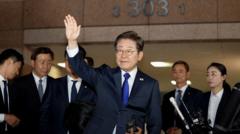In a significant diplomatic move, the United States has sent a nuclear deal proposal to Iran, confirmed the White House on Saturday. The development, delivered by US special envoy Steve Witkoff, comes at a time when Iran has reportedly increased its production of enriched uranium, according to a recent statement from the UN nuclear watchdog. Iranian Foreign Minister Abbas Araghchi was informed of the proposed deal by Oman's foreign minister during a visit to Tehran. The proposal has sparked debate, with US officials emphasizing that accepting it serves Iran's best interests, while Iran maintains its stance that its nuclear activities are purely peaceful.
US Proposes New Nuclear Deal to Iran Amidst Rising Tensions

US Proposes New Nuclear Deal to Iran Amidst Rising Tensions
The US has formally submitted a proposal for a nuclear deal to Iran, prompting responses from both nations as concerns over Iran's uranium enrichment escalate.
Iran's uranium enrichment levels have raised global concerns, as a report from the International Atomic Energy Agency (IAEA) revealed that Tehran now possesses more than 400kg of uranium enriched to 60% purity. This level is perilously close to the 90% threshold needed for bomb-grade material. As Iran's nuclear capabilities expand, US spokesperson Karoline Leavitt underscored that President Trump is committed to ensuring Iran never acquires nuclear weapons. Meanwhile, Iranian officials dismissed the IAEA report as politically motivated and asserted they would respond appropriately to any opposition at future IAEA meetings.
Negotiations between the US and Iran, mediated by Oman, have been ongoing since April, albeit with persistent divisions over key issues such as the future of Iran's enrichment activities. Despite the protracted talks, the IAEA report indicated that Iran's nuclear enrichment efforts have not slowed, equating to roughly one nuclear bomb's-worth of material per month over the last quarter. US assessments suggest that if Iran opted for a weapon, it could produce the required materials within weeks.
The backdrop of this renewed dialogue lies in the context of the Joint Comprehensive Plan of Action (JCPOA), originally established in 2015 to limit Iran's nuclear abilities in exchange for relief from sanctions. However, after withdrawing from the agreement in 2018, Trump imposed stricter sanctions, leading Iran to progressively violate the JCPOA’s constraints. With the stakes higher than ever, the outcome of these negotiations remains uncertain as both sides weigh their options in this critical diplomatic landscape.
Negotiations between the US and Iran, mediated by Oman, have been ongoing since April, albeit with persistent divisions over key issues such as the future of Iran's enrichment activities. Despite the protracted talks, the IAEA report indicated that Iran's nuclear enrichment efforts have not slowed, equating to roughly one nuclear bomb's-worth of material per month over the last quarter. US assessments suggest that if Iran opted for a weapon, it could produce the required materials within weeks.
The backdrop of this renewed dialogue lies in the context of the Joint Comprehensive Plan of Action (JCPOA), originally established in 2015 to limit Iran's nuclear abilities in exchange for relief from sanctions. However, after withdrawing from the agreement in 2018, Trump imposed stricter sanctions, leading Iran to progressively violate the JCPOA’s constraints. With the stakes higher than ever, the outcome of these negotiations remains uncertain as both sides weigh their options in this critical diplomatic landscape.






















